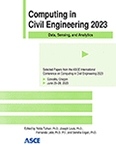Breaking Down Barriers: A Study of Challenges to Adopting Powered Exoskeletons in the US Construction Industry
Publication: Computing in Civil Engineering 2023
ABSTRACT
Powered exoskeletons have the potential to reduce the physical demands on construction workers and enhance their abilities, yet adoption of this technology has been limited in the US construction sector. To that end, this study aimed to identify the barriers to the adoption of powered exoskeletons in the US construction industry. Firstly, a literature review was conducted to identify commercially available powered exoskeletons suitable for construction. Concurrently, questionnaires were developed and distributed among construction practitioners to understand the challenges associated with the implementation of powered exoskeletons in the US construction industry. The results showed that concerns about usability and productivity gains were the main barriers to the adoption of exoskeletons in the construction sector. The findings of this study provide valuable insights for improving the adoption and implementation of powered exoskeletons in the US construction industry, which could enhance worker safety and productivity.
Get full access to this article
View all available purchase options and get full access to this chapter.
REFERENCES
Antwi-Afari, M. F., H. Li, D. J. Edwards, E. A. Pärn, J. Seo, and A. Y. L. Wong. 2017. “Biomechanical analysis of risk factors for work-related musculoskeletal disorders during repetitive lifting task in construction workers.” Autom Constr, 83: 41–47. Elsevier B.V. https://doi.org/10.1016/j.autcon.2017.07.007.
Bureau of Labor Statistics. 2020. Nonfatal cases involving days away from work: selected characteristics.
Davila Delgado, J. M., L. Oyedele, A. Ajayi, L. Akanbi, O. Akinade, M. Bilal, and H. Owolabi. 2019. “Robotics and automated systems in construction: Understanding industry-specific challenges for adoption.” Journal of Building Engineering, 26: 100868. Elsevier. https://doi.org/10.1016/J.JOBE.2019.100868.
Kim, S., A. Moore, D. Srinivasan, A. Akanmu, A. Barr, C. Harris-Adamson, D. M. Rempel, and M. A. Nussbaum. 2019. “Potential of Exoskeleton Technologies to Enhance Safety, Health, and Performance in Construction: Industry Perspectives and Future Research Directions.” IISE Transactions on Occupational Ergonomics and Human Factors, 7 (3–4): 185–191. Taylor & Francis. https://doi.org/10.1080/24725838.2018.1561557.
Lee, H., W. Kim, J. Han, and C. Han. 2012. “The technical trend of the exoskeleton robot system for human power assistance.” International Journal of Precision Engineering and Manufacturing 2012 13:8, 13 (8): 1491–1497. Springer. https://doi.org/10.1007/S12541-012-0197-X.
Linner, T., M. Pan, W. Pan, M. Taghavi, W. Pan, and T. Bock. 2018. “Identification of usage scenarios for robotic exoskeletons in the context of the Hong Kong construction industry.” ISARC 2018 - 35th International Symposium on Automation and Robotics in Construction and International AEC/FM Hackathon: The Future of Building Things. International Association for Automation and Robotics in Construction I.A.A.R.C). https://doi.org/10.22260/ISARC2018/0006.
Ojha, A., M. Habibnezhad, H. Jebelli, and R. Leicht. 2022. “Barrier Analysis of Effective Implementation of Robotics in the Construction Industry.” Construction Research Congress 2022, 661–669. Reston, VA: American Society of Civil Engineers. https://doi.org/10.1061/9780784483961.069.
Passmore, D., C. Chae, V. Borkovskaya, R. Baker, and J. H. Yim. 2019. “Severity of U.S. Construction Worker Injuries, 2015-2017.” E3S Web of Conferences, 97: 06038. EDP Sciences. https://doi.org/10.1051/E3SCONF/20199706038.
Sue Dong, X., E. Betit, A. Marie Dale, G. Barlet, and Q. Wei. 2020. Quarterly Trends of Musculoskeletal Disorders and Interventions in the Construction Industry.
The Construction Chart Book. 2013. Silver Spring, MD: CPWR- the Center for Construction Research and Training.
Valero, E., A. Sivanathan, F. Bosché, and M. Abdel-Wahab. 2016. “Musculoskeletal disorders in construction: A review and a novel system for activity tracking with body area network.” Appl Ergon, 54: 120–130. Elsevier. https://doi.org/10.1016/J.APERGO.2015.11.020.
Wang, D., F. Dai, and X. Ning. 2015. “Risk Assessment of Work-Related Musculoskeletal Disorders in Construction: State-of-the-Art Review.” J Constr Eng Manag, 141 (6): 04015008. American Society of Civil Engineers. https://doi.org/10.1061/(ASCE)CO.1943-7862.0000979.
Wang, X., X. S. Dong, S. D. Choi, and J. Dement. 2017. “Work-related musculoskeletal disorders among construction workers in the United States from 1992 to 2014.” Occup Environ Med, 74 (5): 374–380. Occup Environ Med. https://doi.org/10.1136/OEMED-2016-103943.
Information & Authors
Information
Published In
History
Published online: Jan 25, 2024
ASCE Technical Topics:
- Automation and robotics
- Bibliographies
- Business management
- Construction engineering
- Construction industry
- Construction management
- Employment
- Engineering fundamentals
- Information management
- Labor
- Occupational safety
- Personnel management
- Practice and Profession
- Productivity
- Public administration
- Public health and safety
- Safety
- Systems engineering
Authors
Metrics & Citations
Metrics
Citations
Download citation
If you have the appropriate software installed, you can download article citation data to the citation manager of your choice. Simply select your manager software from the list below and click Download.
